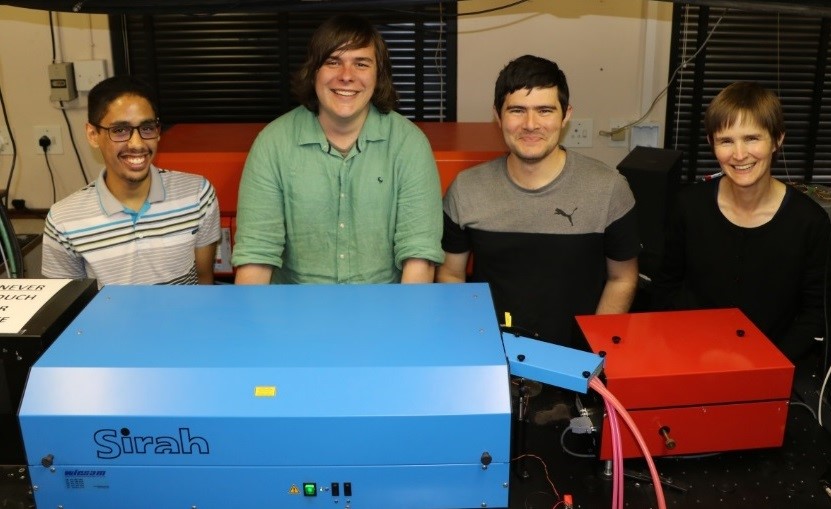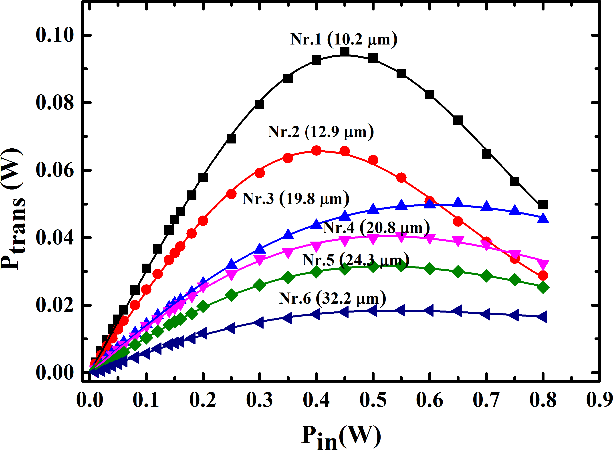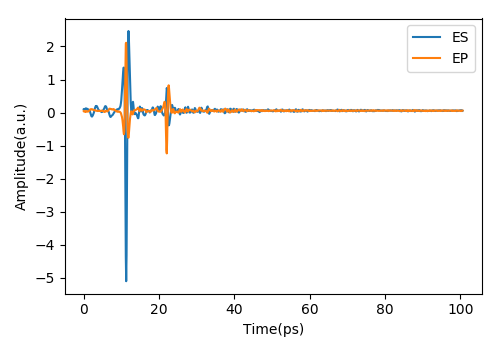Spectroscopy & Laser Diagnostics
?High resolution laser spectroscopy
Christine Steenkamp, Erich Rohwer
The main experimental focus has changed since 2017 to the application of Resonant Ionisation Spectroscopy (RIS) for radioactive isotope production, due to opportunities for collaboration with nuclear physics (including iThemba LABS) and industry in this field.
Resonant Ionisation Spectroscopy (RIS) refers to the selective excitation of a particular atomic isotope to an excited state by means of resonant light, followed by photo-ionisation and extraction of the resulting ion. It is a technique used for high resolution spectroscopy of atoms and for selective extraction of atomic isotopes. RIS is used increasingly in the interdisciplinary field of the production and study of novel radioactive isotopes, with applications to both fundamental nuclear science and for the production of medical radioisotopes for medical imaging and therapy.
The project has attracted the interest of academic and industry collaborators and has therefore developed two foci with different collaboration partners.
In collaboration with iThemba LABS and the 中国体育彩票 KU Leuven in Belgium we plan to apply RIS to high resolution spectroscopy of tin (Sn), with possible extension to other atoms. Dr Steenkamp has participated in a RIS experiment on gallium (Ga) at ISOLDE, CERN. Our contribution at the LRI will be to investigate and optimise the ionisation scheme using stable isotopes, in preparation for application of the technique to exotic radioactive isotopes of these elements Sn is important in basic nuclear physics being at and close to the Z=N=50 double magic structure (number of protons = number of neutrons = 50). In-gas-jet RIS of rare Sn and Ag isotopes are proposed as first day experiments at the new GANIL S3 facility in Caen (France) after its commissioning and optimisation of the method using stable isotopes is essential. On the applications side our efforts in this field will contribute to develop the South African Isotope Facility at iThemba LABS for production of radioactive ion beams for nuclear and material science and to produce new generation medical isotopes.

| The RIS team: Brandon Hattingh, Frederick Waso, André de Bruyn, Christine Steenkamp. |
In addition collaboration with a South African company, SaPhotonica, and collaborators from the 中国体育彩票 of Oslo and Norsk Medisinsk Syklotronsenter in Norway is being developed, aimed at the production of pure isotopes for medical use. The long term aim will be the commercial production of radiopharmaceuticals based on Zn in both South Africa and Norway. The contribution from our lab will be the high resolution spectroscopy on Zn isotopes and optimisation of the ionisation scheme.
Collaboration:
The collaboration with iThemba LABS and KU Leuven has already provided me with the opportunity to participate in a 5-day experiment at the ISOLDE facility at CERN, Genève, Switzerland together with the group from KU Leuven during October 2017. I have applied successfully for the staff exchange programme between Stellenbosch 中国体育彩票 and KU Leuven and plan a 3 months collaborative research visit to Leuven during 2018.
In the SaPhotonica-Oslo-Stellenbosch collaboration a collaboration agreement has been signed during 2017 and external funding is being raised for this project.
Outputs on CO spectrosocpy:
We are preparing a paper on our past spectroscopy project of high resolution vacuum ultraviolet spectroscopy of carbon monoxide. Due to the possibility to use CO data from space and the lab to determine the variation of the electron-to-proton mass ratio over astronomical time scales new and more accurate spectroscopic data on the A-X system of 12C16O and 13C16O has been published. We are using the new data to improve the calibration of our measured spectra to yield absolute wavenumber values that have uncertainties in the range of 10-7, which is of the same order as measurements done by leading groups. We are therefore recalibrating our measurements for a publication.
Carbon monoxide (CO) is the second most abundant molecule in space and measurements of CO spectral lines are used to map the distribution of molecular matter in stellar, planetary and cometary atmospheres and interstellar gas clouds. We measured data on the weak spectral lines of forbidden transitions for which accurate laboratory measured wavelengths are not yet available. These transitions are of particular importance, since the weak lines do not saturate in astronomy measurements and can provide quantitative information. A wavelength tuneable vacuum ultraviolet laser source (approximately 130-160 nm) with a narrow spectral bandwidth was used in this project. The VUV light is generated by 3rd order sum-frequency generation in a Mg vapour-Kr gas medium.
Second harmonic generation project
Erich Rohwer, Christine Steenkamp, Pieter Neethling
The project involves the investigation of charge carrier dynamics across the silicon-silicon dioxide interface under femtosecond laser irradiation. This charge carrier transfer is monitored through second harmonic generation. The movement of electrons and holes across the interface establishes an interfacial electric field, which significantly enhances the second harmonic signal. This phenomenon is termed electric field induced second harmonic (EFISH). This project currently focuses on measuring the EFISH signal both in a transmission and reflection geometry simultaneously. In all previous reports in literature EFISH has always been measured in a reflection geometry.
The silicon samples under investigation were manufactured at the Institute for Photonic Technology (IPHT) in Jena. Single crystalline free-standing silicon micro membranes (15-40 μm thick) were produced by chemical etching of bulk silicon.
An experimental setup to measure the EFISH signals of the Si/SiO2 samples in transmission and reflection was developed to simultaneously measure the reflected and transmitted EFISH signals from these Si membranes. This is a significant improvement over the previous sequential measurements.

| Figure indicting the transmitted power through silicon membranes of different thicknesses as a function of incident power. |
During 2015 and 2016 numerous measurements were performed, simultaneously measuring the EFISH signal in transmission and reflection from a variety of Si/SiO2 samples (different thicknesses). The results have shown that the electric field generation process is much more complicated than previously anticipated. These measurements were repeated and expanded on during 2016. The main activity during 2016 has been the refinement of the physical model describing the unexpected transmission results. This decrease cannot be explained through nonlinear processes and the refined model describing this phenomenon was published during 2016.
One publication appeared during 2016: Heisel, P.C., Ndebeka, W.I., Neethling, P.H. et al. “Free charge carrier absorption in silicon at 800 nm", Appl. Phys. B (2016) 122: 60.
In 2017, Wilfrid Ndebeka (now a Postdoctoral fellow) together with Prof H Stafast, continued with the analysis of results obtained from 2015 – 2016; a free charge carrier absorption (FCA) model was developed to help understand the transmission behaviour of the signal obtained in transmission geometry. The transmission behaviour at high power is attributed to FCA. The model uses an effective absorption coefficient with increasing with the average laser intensity (input power). The linear (interband transition) is used to determine the membrane thickness d in the 10 – 30 ?m range by two ways, using either the linear absorption regime at low power (Beer's law) or the related fit parameters of the applied FCA model.
Results of this work were published in 2017 in the Applied Physics B Journal: “Interband and free charge carrier absorption in silicon at 800 nm: experiments and model calculations", Appl. Phys. B (2017) 123:253.
Another paper on simultaneous second harmonic generation in transmission and reflection from the same silicon membrane is on the pipeline and will be submitted later this year for publication.
The project is still under the guidance of Prof E. Rohwer, Dr P. Neethling, Dr C. Steenkamp and in collaboration with Prof Stafast from the Leibniz Institute of Photonic Technology, Jena, Germany.
Terahertz time-domain spectroscopy
Erich Rohwer, Pieter Neethling
During 2017 there was one PhD student, Shane Smith, working on the project. His project entails the design, construction and evaluation of a time-domain THz ellipsommetry setup. The aim of the project is to be able to extract material parameters from samples in aqueous environments, something which is not possible with the current transmission setup due to the strong absorption by water in this frequency range. This will allow for the investigation of biological samples, which ties in with the current initiatives within the LRI towards bio-photonics. During 2017, measurements were performed on simple samples, for which the data could be verified against that of Terahertz transmission spectroscopy. In parallel, Shane has been writing software that will enable the extraction of the complex refractive index from measurements using the ellipsometry setup. This has proven more challenging than expected but gradual progress is being made. During early 2018, liquid sample measurements are being performed, the first publication should be forthcoming from the project. The design and construction of the setup is novel and is definitely publishable.
? | ? |
Terahertz electric field measured (both S and P reflections) for a 500?m undoped silicon wafer
| Terahertz electric field measured (both S and P reflections) for a silicon cuvette filled with water
|
X-rays and laser applications at the Central Analytical Facility
Anton du Plessis
Dr Anton du Plessis is one of the graduates of the LRI and still maintains research links here. He is currently involved in laser based additive manufacturing and X-ray tomography applications in a department of the Central Analytical Facility of Stellenbosch 中国体育彩票.
For more on his research and his publications see this link: http://blogs.sun.ac.za/duplessis




